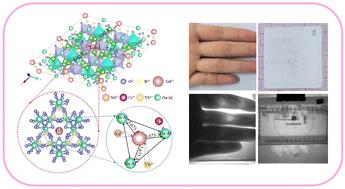Subgrid cage confinement engineering enabled ultra-efficient near-infrared Cr3+–Ln3+ co-doped phosphors
IF 6.4
1区 化学
Q1 CHEMISTRY, INORGANIC & NUCLEAR
引用次数: 0
Abstract
Precise control of energy migration between Cr3+ sensitizers and Ln3+ activators at the topochemical subgrid level remains a fundamental challenge. Herein, a novel subgrid cage confinement engineering strategy was proposed, achieving ultra-efficient near-infrared (NIR) Cr3+–Ln3+ (Ln = Yb, Nd, Er) co-doped phosphors. The bilayer cage architecture of GdAl1.5Ga1.5(BO3)4 precisely confines Ln3+ at the central Gd3+ sites, while providing octahedral lattice positions for Cr3+ substitution within the Al/GaO6 framework. This unique confinement constrains Cr3+–Ln3+ separation to the optimal 3.67 Å while increasing the Ln3+–Ln3+ distance to 5.92 Å, enabling highly efficient Cr3+–Ln3+ energy transfer (ηETE: 61% for Yb3+, 82% for Nd3+, 46% for Er3+) and suppressing energy losses between neighbouring Ln3+ ions. Consequently, the Cr3+–Yb3+ co-doped system achieved a high photoluminescence quantum yield of 86% and retained 94% of its intensity even at 423 K, demonstrating exceptional thermal stability. The fabricated NIR phosphor-converted light-emitting diodes delivered a NIR output power of 127 mW with a photoelectric efficiency of 13% under a 300 mA operating current. These capabilities enabled high-contrast biological imaging applications, such as vein visualization and non-destructive testing, as validated by prototype demonstrations.

亚栅格笼约束工程实现了超高效近红外Cr3+ -Ln3 +共掺杂荧光粉
在拓扑化学亚网格水平上精确控制Cr3+敏化剂和Ln3+激活剂之间的能量迁移仍然是一个根本性的挑战。为此,提出了一种新的亚栅格笼约束工程策略,实现了超高效近红外(NIR) Cr3+ -Ln3 + (Ln = Yb, Nd, Er)共掺杂荧光粉。GdAl1.5Ga1.5(BO3)4的双层笼结构精确地将Ln3+限制在Gd3+的中心位置,同时为Al/GaO6框架内的Cr3+取代提供八面体晶格位置。这种独特的约束将Cr3+ -Ln3 +的分离限制在最佳的3.67 Å,同时将Ln3+ -Ln3 +的距离增加到5.92 Å,实现了Cr3+ -Ln3 +的高效能量转移(ηETE: Yb3+ 61%, Nd3+ 82%, Er3+ 46%),并抑制了相邻Ln3+离子之间的能量损失。因此,Cr3+ -Yb3 +共掺杂体系实现了86%的高光致发光量子产率,即使在423 K下也保持了94%的强度,表现出优异的热稳定性。在300 mA工作电流下,制备的近红外磷转换发光二极管输出功率为127 mW,光电效率为13%。这些功能实现了高对比度生物成像应用,如静脉可视化和非破坏性测试,并通过原型演示验证。
本文章由计算机程序翻译,如有差异,请以英文原文为准。
求助全文
约1分钟内获得全文
求助全文
来源期刊

Inorganic Chemistry Frontiers
CHEMISTRY, INORGANIC & NUCLEAR-
CiteScore
10.40
自引率
7.10%
发文量
587
审稿时长
1.2 months
期刊介绍:
The international, high quality journal for interdisciplinary research between inorganic chemistry and related subjects
 求助内容:
求助内容: 应助结果提醒方式:
应助结果提醒方式:


